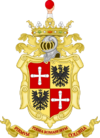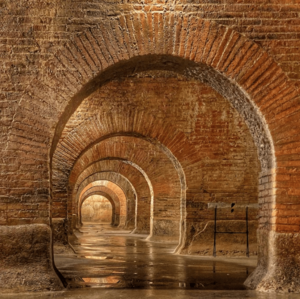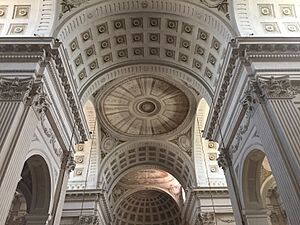Fermo facts for kids
Quick facts for kids
Fermo
|
|||
|---|---|---|---|
| Città di Fermo | |||

Panorama of Fermo.
|
|||
|
|||

Fermo within the Province of Fermo
|
|||
| Country | Italy | ||
| Region | Marche | ||
| Province | Fermo (FM) | ||
| Frazioni | see list | ||
| Area | |||
| • Total | 124 km2 (48 sq mi) | ||
| Elevation | 319 m (1,047 ft) | ||
| Population
(30 June 2015)
|
|||
| • Total | 37,732 | ||
| • Density | 304.3/km2 (788/sq mi) | ||
| Demonym(s) | Fermani | ||
| Time zone | UTC+1 (CET) | ||
| • Summer (DST) | UTC+2 (CEST) | ||
| Postal code |
63900
|
||
| Dialing code | 0734 | ||
| Patron saint | St. Maria Assunta | ||
| Saint day | August 15 | ||
Fermo is a historic town in the Marche region of Italy. It is the main town in the Province of Fermo.
Fermo is built on a hill called Sabulo, which is about 319 meters (1,047 feet) high. It's located near the Adriatic coast, connected to the railway at Porto San Giorgio.
Contents
History of Fermo
Ancient Beginnings
The earliest signs of people living in the Fermo area date back a very long time. Around 9th to 8th centuries BC, there were communities from the Villanovan culture. These were early groups in Italy, known for their unique pottery and burial customs.
Later, in 264 BC, the Romans founded a Latin colony here. They called it Firmum Picenum. It was an important center for Roman power in the region. The town remained loyal to Rome throughout its history.
Medieval Times
In the 8th century, Fermo came under the control of the Holy See (the Pope's authority). It became part of a larger area known as the March of Ancona. In the 10th century, it even became the capital of its own region, the Marchia Firmana.
For a while, the bishops of Fermo gained special powers. They acted like local rulers, managing the town's affairs.
A Free City
In 1199, Fermo became a free city. This meant it could govern itself, much like many other Italian cities at the time. It stayed independent for a long time, until 1550.
During these years, Fermo was often caught in conflicts. It was attacked and captured several times by different groups. Finally, in 1550, it became part of the Papal States, which were lands directly ruled by the Pope.
Modern Fermo
Fermo has continued to be an important town. Since 2009, it has been the capital city of the new Province of Fermo.
Exploring Fermo's Sights
Ancient Roman Discoveries
Fermo has exciting archaeological sites that show its ancient past. Three large ancient burial grounds, called necropolises, have been found. These show us how people lived and were buried thousands of years ago. Many items found here are now in museums.
You can also see the remains of a Roman theatre. There are also small traces of an amphitheater. Parts of the old city wall, made of strong limestone blocks, can still be seen.
One of the most amazing sites is the cisterns of Fermo. These were built around the 1st century AD. They are a huge system of 30 underground rooms. These rooms collected and stored water for the city, probably supplying public fountains. The cisterns were built with a special waterproof Roman concrete. They could hold about 3,000 cubic meters (nearly 800,000 gallons) of water!
Beautiful Natural Spots
The Forest of Cugnolo is a special natural area near Torre di Palme. It's a rare example of an untouched Mediterranean forest along the Adriatic Sea coast. It covers about 5 hectares (12 acres) and is a protected area. You can explore it on a special walking path.
Important Buildings
The Palazzo dei Priori is a very old and important building. It was built between 1296 and 1525. Look for the large metal statue of Pope Sixtus V above the main entrance! This palace now holds the town's art gallery and ancient collections. The town's library, Biblioteca Comunale, also has old writings and artifacts.
Religious Buildings
The Fermo Cathedral is a major church in Fermo. Digs under the church have found remains from the 2nd century AD and an early Christian church from the 6th century AD. This older church was destroyed in 1176 and rebuilt in 1227.
The cathedral has a beautiful Gothic front made of Istrian stone. It features a lovely rose window from 1348 and an old bell tower. Inside, you can see how it was rebuilt in the late 1700s. The cathedral is said to own a special robe that belonged to Thomas Becket, a famous saint.
Other notable churches in Fermo include:
- San Francesco
- San Martino
- San Domenico
- San Michele Arcangelo
- San Rocco
- Chiesa della Pietà
- Santa Maria del Carmine
- San Filippo
- San Zenone
- San Agostino
- Santuario della Madonna del Pianto
Geography of Fermo
Amazing Views
From the top of the Girfalco or Girone hill, you get an incredible 180-degree view. You can see the coast, and look north towards Macerata and south towards Monterubbiano. On very clear days, you might even see the mountains of Croatia across the sea! Another great place for views is Torre di Palme, a small village south of Fermo, which overlooks the sea.
Local Villages (Frazioni)
Fermo includes many smaller villages and areas called frazioni. These include Camera, Campiglione, Cantagallo, Casabianca, Capodarco, Cartiera di Tenna, Concerie, Contrada Boara, Ete Palazzina, Faleriense, Gabbiano, Girola, Lido di Fermo, Madonnetta d'Ete, Marina Palmense, Moie, Molini Tenna, Montesecco, Montone, Parete, Pompeiana, Ponte Ete Vivo, Sacri Cuori, Salette, Salvano, San Biagio, San Girolamo, San Lorenzo, San Marco, San Michele, Lido San Tommaso, Torre di Palme and Villa San Claudio.
Twin Towns
Fermo has "twin town" relationships with other cities around the world. These partnerships help promote cultural exchange and friendship.
 Berat, Albania
Berat, Albania Bahía Blanca, Argentina
Bahía Blanca, Argentina Ansbach, Germany, since 2006
Ansbach, Germany, since 2006 León, Mexico
León, Mexico
Famous People from Fermo
Many interesting people have come from Fermo, including:
- Blessed John of Fermo (1259–1322)
- Decio Azzolino (1623–1689), a cardinal (a high-ranking official in the Catholic Church)
- Melissa Bellucci (2001-), a footballer (plays midfield for Juventus)
- Annibale Caro (1507–1566), a poet
- Francesco Graziani (1828–1901), an opera singer
- Lodovico Graziani (1820–1885), an opera singer
- Alessandro Maggiori (1764–1834), an art collector
- Savino Monelli (1784–1836), an opera singer
- Augusto Murri (1841–1932), a physician (doctor)
See also
 In Spanish: Fermo para niños
In Spanish: Fermo para niños







